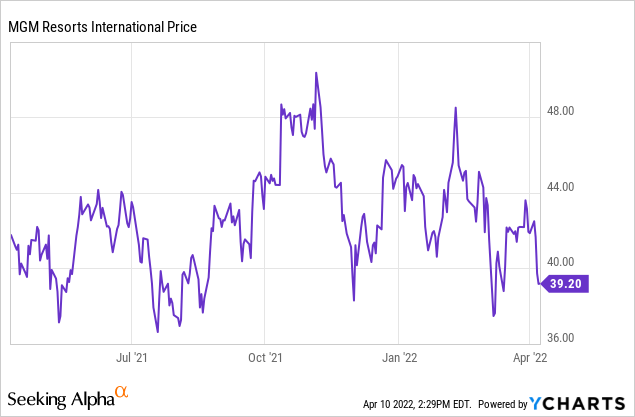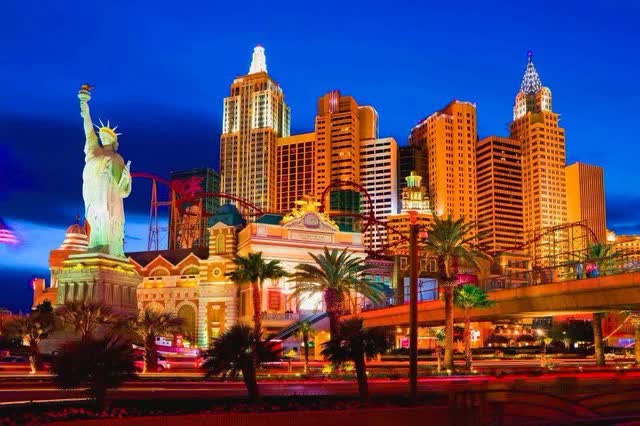
The Las Vegas Strip has come out of the covid cave and is revving up fast. MGM is at the forefront of record revenue recovery.
RandyAndy101/iStock Editorial via Getty Images
The Las Vegas Strip has come out of the covid cave and is revving up fast. MGM is at the forefront of record revenue recovery.
RandyAndy101/iStock Editorial via Getty Images
Assume you’ve read about the recovery of revenue on the Las Vegas strip as Covid fear begins to subside and you are inclined to kick the tires on the market leaders there, specifically, MGM Resorts International (NYSE:MGM). You may read a report here and there, perhaps talk to a broker. But before anything, you know it is de rigueur for any savvy investor to read the latest annual report for the most comprehensive portrait of a company, warts and all. (If you can find them in the mice type).
You may also click onto the year-end earnings call transcript and listen to how top managers tell you «we’re excited» and «we’re happy» and «we’ve done this and that». And of course, «we realize….» All in all, it’s wise to gather as much information as you can to make as prudent a decision as you can, given the current whirlwind times in which we look for best returns.
Good luck, living in this world of TMI, where one can be focused by info. But these days more than likely you’ll be drenched or drowned in data. Just try and read an annual report to pluck out bits and pieces of info to inform your decision. You will soon be in the world of MEGO (my eyes glaze over) when you get to the charts and graphics where often the warts are either hidden or the alphas in hiding.
As readers of this space know, I attempt to populate my analysis of gaming stocks with the accumulated knowledge, best instincts, and hard-won, hands-on management experience of 35 years in the gaming fields. I’ve struck my share of dry holes as well as gushers in the process. When so massive a trove of data and information on a high cap stock exists, as it does for MGM as a market leader, you can easily get confused. That’s why some analysts read the same metrics and like what they see, while others sniff at the numbers and urge investors to take a pass.
The gaming business is at once an easy one to follow as well as a complex one to understand. It is one of the few highly regulated businesses mandated to report its monthly revenues, even weekly revenues in some cases, for all the world to see. And that means that investors can look at the numbers and see if the company won more money this month than last, if it is trending ahead or below its market share, or if its revenue mix of gaming vs. non-gaming is teetering in one direction or another.
It is a business which, as they say, everyone cooks with water. A slot machine is a slot machine, no matter the logo on the building’s sign. Yet some operators consistently outperform their peers and lead markets and others just bump along for the ride. When the town is loaded with bodies, everyone does well. When it’s a ghost town, everyone cuts into shifts, furloughs employees, reduces costs.
But on closer examination, you begin to discern the differences between operators. Some aim heavy cannonades to the VIP, upper end of the gaming customer spectrum. Others try to hit the middle, still others are happily pushing low rolling budget tourist gamblers through their casino floors in droves.
That begs the question then: Is there a company that has found a way to address the entire gaming customer spectrum, one that essentially says: We want everyone who gambles, big, middle, small, anywhere at any time, to taste what we have to sell. We want non-gamers too. We love conventioneers. We look at the world of gamblers as one big happy mass of people living or travelling to our geography wherever or whenever they wish. It’s a tough contract. Not every company has done the spade work, has made the investments, has aggressively sought to expand its footprint, and has taken on a ton of debt to further than its purpose. MGM has, in spades.
The ecosphere of gaming for everyone is occupied by such companies as Caesars Entertainment (CZR), Penn National Gaming (PENN) and Boyd Gaming Corporation (BYD) – all fine exponents of the single wallet theory of gaming business: Have everything under the sun a gaming customer could possibly want and serve it up in as many places as seems smart.

Yet each one has set down a geographic border. CZR, Penn, and BYD have no existing businesses in Asia, for example. Penn has no dominant presence on the Las Vegas strip. Other than BYD, none of the single wallet operators have a heavy presence in the Las Vegas locals market. Wynn Resorts, Ltd. (WYNN) has dipped a toe into the sports betting fracas, found the water a bit cold and has hung the for sale sign on its WynnBET business.
Churchill Downs, in racing and casinos, has seen the same ocean of red ink ahead and left the sports betting business.
Only one company stands out, fighting its way into every inch of territory that opens, looking to become not just a strong single wallet operator in the US, but a global leader. That’s MGM; for better or worse, they want to dance at every wedding. And for investors, the bottom line is better, much better ahead.
It is a bit of reductio ad absurdum, I confess, but I use the metaphor the Swiss Army Knife as what I believe best tells the story to investors of MGM as a company and as an investment better than blizzards of numbers alone.

MGM archives
MGM archives
This research company which follows gaming global trends has most recently published their estimates of total growth for the industry from 2017 through 2026.
(Note: The study does take into consideration the pandemic setbacks experienced from 2020 and continuing at a bit of a diminishing rate since).
Total gaming revenue, all sectors by 2026: $876b. Of this lotteries will generate $376b. So, we deduct that amount from our long-term number and the result is this: the casino, online, sports betting and iGaming together are projected to generate $525b by 2026. The US will grow to $262b, and Asia-Pacific, which includes Macau will hit $322b bringing the total to about $589b-globally including all other world regions in the EU, Africa, Oceana, etc.
US brick and mortar casinos are forecasted to reach $149b in revenue by 2026 against a pre-pandemic base of $71b including commercial and tribal properties. Best US estimate for sports betting is ~ $25 to $30b including iGaming.
R&M lists 20 companies in the direct to player segment of the total gaming spend-ex of equipment manufacturers. MGM is among the core 20 as are all of its single wallet competitors.
Of that segment, MGM has the broadest coverage of global gaming’s present and future because it is the only one with established consumer-facing businesses in them all. It is also the only company in the sector with a firm commitment to Japan’s future IR market, estimated to generate around $13 to $15b in revenue by 2032. MGM is now operating on the Las Vegas Strip, US Regionals, Macau and of course, BetMGM, for online, digital and sports betting. (The Las Vegas locals market is dominated by Boyd Gaming with local competitors like Red Rock Resorts (RRR).
But the other single wallet leaders are positioned as follows:
In other words, like that most famous, handiest and longest surviving of personal tools, the Swiss Army knife, MGM is a company totally adapted to whatever use may come or be anticipated. Whether it is brick and mortar properties, an LV strip presence, online sports and iGaming sites, properties in ultimately recovering Asian markets, MGM shares offer a foundational portfolio holding for investors active or not in the gaming space.
In effect, if you own MGM, you will participate in its present – slowly recovering from the pandemic in its US businesses – and its future – the rapid growth of BetMGM whose losses are now underwritten by its brick and mortar cash flows. Yet its price at writing is $39.20 against a Discounted Cash Flow estimate of $49 a share, it is ~20% undervalued.
Our analysis builds in what we believe will be a faster, broader-based recovery on the LV Strip convention business, its regional properties as well as its growing market share for BetMGM than is built into the DCF formula most analysts are now using. Price targets vary from $53 to $55.
Our PT by the end of 3Q22 is: $62 a share, above the $51 high of its 52-week range. We arrive at that price because we see a faster return of convention and tourist business midweek to Las Vegas, a diminishing loss trend on its online business and the growing prospect that at some point it will acquire the 50% of Entain (Its UK digital partner) strongly supported by key holder IAC/InterActiveCorp (IAC). Two of IAC’s top dogs – ecommerce and movie marketing genius Barry Diller and IAC top guy digital veteran Joey Levin – sit on the MGM board. They are not the type of guys who are potted plant directors. MGM shareholders are well served by their presence.
These guys are not there for the comps to restaurants, suites, or ringside seats for fights or director’s fees. They have already invested $1b in MGM shares and have publicly stated they are prepared to dig for more should the company need a cash infusion to acquire more digital businesses – read Entain.
Some analysts express concern over MGM’s long-term debt which now sits at a clearly big time $12.4b representing deals and financings of some operations as well as many transactions on properties acquired or investments in BetMGM.
Yet its current ratio is 1.86, healthy by most any applicable standard. Cash on the books at the 2021 close was $4.7b.
In the still pandemic impacted 2021 year, MGM generated $9.6b in revenues vs. $12.8b in baseline 2019. But net income for 2021 was $1.25b vs. $2.044b for baseline 2019. No pom-pom waving here of course. But it is undeniable that MGM’s recovery trend emanating from the LV strip validates its strategy of having an inventory of 32,595 rooms available as customers return in larger numbers. And yet, the core convention business, much of it booked ahead, has yet to show its power for MGM. And the return in force of that segment is part of the equation we used to calculate our PT.
Its overall strategy is evident in the continuing flow of transactions MGM moves on; property realty sales to REITs, the sale of its own REIT, MGP, to VICI Properties (VICI), acquisitions on the strip, expansions in the regional space, ongoing support for its BetMGM business.
Its MLife rewards customer base is now above 34m and like CZR, it offers comp points to sports bettors toward stays at MGM properties both in Vegas and the regions. That is the core strategy of all single wallet operators: create an ecosphere of your own so your customers needn’t go anywhere else for anything else. The big difference here is that the MGM ecosphere envisions a global, rather than just a dominant US presence.
For the full 2012 year, BetMGM, its sports betting partnership with Entain, generated $850M in revenue, with an operating loss of $211m. The site, according to MGM, now has an 18% share of the US sports betting market operating in 21 states. It is forecasting $1.3b in revenue for 2022 including an expected major spike as Ontario goes live. They aspire to move into profitability by 2023 or before.
The company invested $225m in sports betting in 2020, followed by $80m in 2021. We think the losses for the entire sector will continue as new states come on line-and that includes MGM. But those losses are to an extent, now covered by the improving cash flow health of its brick and mortar business which in brief means one thing: As sports betting consolidates with fewer independent sites, MGM will be among the double-digit share of market survivors in the black.
Bet your bottom dollar there will be sun
The recovery of the huge decimated Macau gaming market at best is getting educated as well as wishful thinking guesses till now. The most recent month in Macau showed a tough 56% GGR decline, sequentially from the prior month. The mother of all headwinds, China’s zero tolerant Covid policy is what keeps the Beijing boot on the neck of the sector with an uncertain easing. MGM, which reported Macau revenues of $1.2b for 2021’s Covid year, had been dipping just over the 10% share of the market prior to the pandemic. Estimates are all over the place and consensus on recovery is a tough contract to sign off for analysts.
Per our usual process, we raised our contact network inside the industry plus sources we long have seen as reliable as can be possible in Asia at this time. We share those views revealed as being held by the largest number of in-the-know individuals in our little survey of 26 industry and industry supply people.
Most agree that Xi Jinping has dug himself into a hole on the zero-tolerance policy. Given the massive, but believed to be relatively mild symptomatic outbreak in locked down Shanghai, there appears to be pressure building among high political circles of Beijing for some kind of easing to save face.
As with everything else in the bizarre world of command economy communism, pronouncements from on high are always considered safest when coming out of big conclaves. For that reason, our panelists widely agree that the safest forecast at this point is that at the November Party Congress, we will see an announcement of considerable easing of travel restrictions and better control of possible lockdowns.
Many agree we could well see easing before that since many Asian jurisdictions are essentially open or beginning to open. Just last week, Singapore announced a complete opening to foreign travelers who are vaccinated and the fall of many other Covid mandates. Similar openings are beginning in the Philippines, Cambodia and South Korea. No suggestion here that Xi or his comrades have any vital concerns about the survival of the Macau gaming industry. What is beginning to hurt is an exacerbation of supply chain woes, of course, the threat to exports and other trillion dollar concerns.

MGM’s plan for Osaka IR moves ahead. (MGM archives)
MGM’s plan for Osaka IR moves ahead. (MGM archives)
What this all means for the MGM China business is this: We see a chance for some upside trickle in visitation as certain travel restrictions might fall before the party congress. But we also see that Q3 and 4 long a more certain promise of meaningful travel restriction easing ahead. MGM’s cash position is strong enough to sustain a continuing loss of revenue through that period and further. But we have not baked in significant EBITDA accretion from MGM China until very late this year, more likely in all probability by 1Q23.
We believe if investors had a choice to add gaming stocks to a diverse consumer discretionary portfolio, the sector remains attractively priced largely due to pandemic-related headwinds that linger. But MGM, with its strong balance sheet, its geographically diverse global footprint now and in the future, is a one size fits all, or a Swiss Army knife. It has all functions ready to perform the task of bringing home the most attractive returns given its dead pooled trading range now. It’s a BUY.
For in-depth and deep dive research on the casino and gaming sector, subscribe to The House Edge. New: Free excerpts from our book in progress "The Smartest ever Guide to Gaming Stocks" – free to existing members and new subscribers.
This article was written by
For 30 years I held senior vp and exec VP positions in major casino hotel operations among them Caesars, Ballys, Trump Taj Mahal and have done extensive consulting assignments for many others in the US, including the native American property Mohegan Sun, in Connecticut. I have also done special projects for Caesars Palace in Las Vegas. I was the founder and publisher of Gaming Business Magazine, first ever publication covering the gaming industry and have written extensively about the industry.
Disclosure: I/we have no stock, option or similar derivative position in any of the companies mentioned, and no plans to initiate any such positions within the next 72 hours. I wrote this article myself, and it expresses my own opinions. I am not receiving compensation for it (other than from Seeking Alpha). I have no business relationship with any company whose stock is mentioned in this article.












